Ceramic Tile on Laminate
DEAR TIM: Our plastic laminate kitchen countertops are in bad shape. They are square edged instead of the common rounded edge tops. I saw a television show where a person simply covered the laminate with ceramic tile. Is this possible? It seems so easy and straightforward. Would you do it this way if it were your home? If not, why? Do you have any tile installation tips? Patty W., Amherst NH
DEAR PATTY: If I had a dollar for every time someone asked me this exact question, I might be in the Virgin Islands. Plastic laminate tops do indeed wear out from heavy use and people often are on a tight budget and are looking for a quick fix. Add to this the typical over-simplification found on many home improvement television shows and you have a recipe for disaster. To answer your question: Yes, it is possible to install ceramic tile on square edged laminate tops. Would it be done at the Tim Carter home? No.

You are looking at ceramic tile on my own kitchen island top. It had been down for over 18 years and still looks as good as the day I grouted it.
Let's assume that we are going to do the tile countertop remodel job for a moment. Here are some things we know we must do: The sink must be removed from the top. The faucet must also be removed. The laminate top must be heavily sanded. Without this abrasion, the mastic or cement-based thinset will very likely fail in a short period of time. Your new tile top can begin to fall apart.
The plastic top does not absorb any moisture whatsoever. If you were to use a water-based adhesive of any type, the only way it would work is that all of the water would have to absorb into the tiles. This may or may not happen. If the tile can't take it all, the adhesive may never fully cure. You can avoid this issue if you use an epoxy, but epoxy adhesives can be a little bit of a hassle to work with for a rookie.
If it were me, instead of taking all of the time to try to sand the top and hope the sanding will work, I would simply remove the old top and replace it with a double layer of exterior grade three quarter inch thick plywood. This material contains special glues that are made to resist repeated wettings in case water somehow gets through the tile. The time spent taking out the old top and installing this new plywood will very likely equal the amount of time spent heavily sanding the laminate. Your only extra expense is the cost of the plywood. Purchasing the plywood also buys enormous peace of mind as the non-epoxy standard tile adhesives will readily adhere to it.
Installing the plywood is somewhat easier than installing the original plastic laminate tops. By yourself, you can screw the first piece of plywood down into the corner blocks of the cabinets. If you are installing a stainless steel sink, you will need to make the cutout hole in the lower piece of plywood two inches larger on all sides than the top piece. The clips that pull the sink tight against the tile are not made to handle the combined thickness of two sheets of plywood and the ceramic tile.
Be sure to grout the new tile with epoxy grout. This grout is surprisingly easy to work with and it is unfazed by the chemicals found in many common foods and juices. These acidic chemicals often cause traditional cement-based grouts to fail within several years.
You might also consider using a wood edge for your new tops. Special bull nose tiles are available that wrap around the front edge of the countertops, but these can be chipped if you are not careful. If you decide to use wood as an edging, be sure you install it after the tile is in place. The best way to insure the tile will be in a straight line as it is installed along the front edge is to install a temporary wood edge that is tightly screwed into the plywood. Remove this stop after the tile is set.
Author's Notes:
I received all sorts of email and calls to my radio show about this column. As you might expect, there are many ways to skin a cat. In this case, many people and contractors have had great luck putting tile on laminate tops. The trouble I sometimes have with my column is the space restrictions imposed by newspapers. I have a very limited amount of room and it is often impossible to discuss all of the options regarding a given topic.
In this instance, there are no less than four or five different ways you can adhere tile to laminate. Sam Vincy of Chicago, IL called me and told me how he had nailed chicken wire to his laminate top and backsplash. He then used cement-based thinset to adhere the tile to the laminate and chicken wire. Since the thinset grabbed onto the wire and the wire was nailed to the top, the tile was solidly attached.
Other folks emailed me and told me how they nailed cement board to the laminate tops. I guess the bottom line is time and money. I feel all of the solutions end up fairly close in time and some cost slightly more than others. My solution outlined in the column above will be more costly as you must buy new plywood to replace the laminate top. But my solution also insures the tile will adhere forever. So long as the nails hold down the wire and cement board in the other situations, you should be bulletproof if you decide to go that route!
Column 465
One Response to Ceramic Tile on Laminate